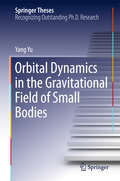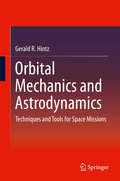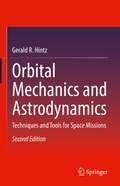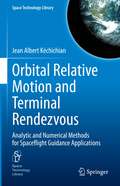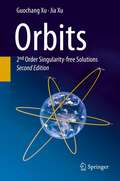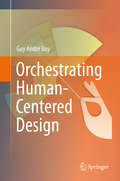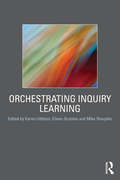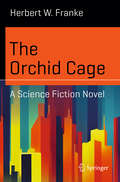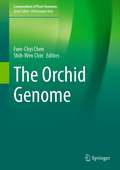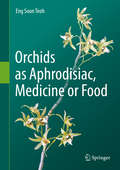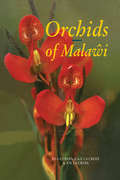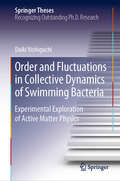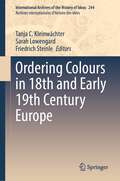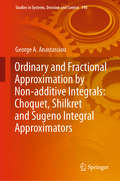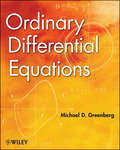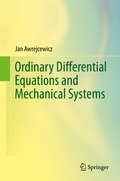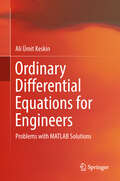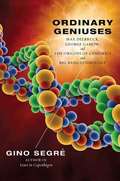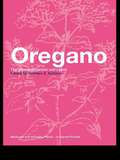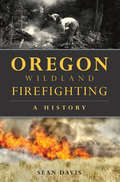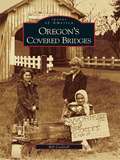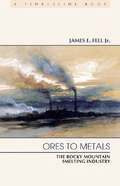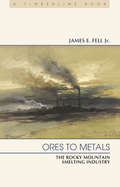- Table View
- List View
Orbital Dynamics in the Gravitational Field of Small Bodies
by Yang YuThis prizewinning PhD thesis presents a general discussion of the orbital motion close to solar system small bodies (SSSBs), which induce non-central asymmetric gravitational fields in their neighborhoods. It introduces the methods of qualitative theory in nonlinear dynamics to the study of local/global behaviors around SSSBs. Detailed mechanical models are employed throughout this dissertation, and specific numeric techniques are developed to compensate for the difficulties of directly analyzing. Applying this method, several target systems, like asteroid 216 Kleopatra, are explored in great detail, and the results prove to be both revealing and pervasive for a large group of SSSBs.
Orbital Mechanics and Astrodynamics
by Gerald R. HintzThis textbook covers fundamental and advanced topics in orbital mechanics and astrodynamics to expose the student to the basic dynamics of space flight. The engineers and graduate students who read this class-tested text will be able to apply their knowledge to mission design and navigation of space missions. Through highlighting basic, analytic and computer-based methods for designing interplanetary and orbital trajectories, this text provides excellent insight into astronautical techniques and tools. This book is ideal for graduate students in Astronautical or Aerospace Engineering and related fields of study, researchers in space industrial and governmental research and development facilities, as well as researchers in astronautics. This book also: · Illustrates all key concepts with examples · Includes exercises for each chapter · Explains concepts and engineering tools a student or experienced engineer can apply to mission design and navigation of space missions · Covers fundamental principles to expose the student to the basic dynamics of space flight
Orbital Mechanics and Astrodynamics: Techniques and Tools for Space Missions
by Gerald R. HintzNow in an updated second edition, this classroom-tested textbook covers fundamental and advanced topics in orbital mechanics and astrodynamics designed to introduce readers to the basic dynamics of space flight. The book explains concepts and engineering tools a student or practicing engineer can apply to mission design and navigation of space missions. Through highlighting basic, analytic, and computer-based methods for designing interplanetary and orbital trajectories, the text provides excellent insight into astronautical techniques and tools. The second edition includes new material on the observational basics of orbit determination, information about precision calculations for data used inflight, such as Mars 2020 with the Ingenuity Helicopter, and improvements in mission design procedures, including the automated design of gravity-assist trajectories. Orbital Mechanics and Astrodynamics: Techniques and Tools for Space Missions is ideal for students in astronautical or aerospace engineering and related fields, as well as engineers and researchers in space industrial and governmental research and development facilities, as well as researchers in astronautics.
Orbital Relative Motion and Terminal Rendezvous: Analytic and Numerical Methods for Spaceflight Guidance Applications (Space Technology Library #39)
by Jean Albert KéchichianThis book provides a comprehensive analysis of time-fixed terminal rendezvous around the Earth using chemical propulsion.The book has two main objectives. The first is to derive the mathematics of relative motion in near-circular orbit when subjected to perturbations emanating from the oblateness of the Earth, third-body gravity, and atmospheric drag. The mathematics are suitable for quick trajectory prediction and the creation of computer codes and efficient software to solve impulsive maneuvers and fly rendezvous missions.The second objective of this book is to show how the relative motion theory is applied to the exact precision-integrated, long-duration, time-fixed terminal rendezvous problem around the oblate Earth for the general elliptic orbit case.The contents are both theoretical and applied, with long-lasting value for aerospace engineers, trajectory designers, professors of orbital mechanics, and students at the graduate level and above.
Orbits
by Guochang Xu Jia XuThe development of the orbits theory lags behind the development of satellite technology. This book provides, for the first time in the history of human satellite development, the complete third order solution of the orbits under all possible disturbances. It describes the theory of satellite orbits, derives the complete solutions of the orbital disturbances, describes the algorithms of orbits determination based on the theory, describes the applications of the theory to the phenomenon of the satellite formation physically. The subjects include: Orbits Motion Equations, Disturbance theory, Solutions of the differential Equations, Algorithms of Orbits determinations, Applications of the theory to the satellite formation.
Orchestrating Human-Centered Design
by Guy BoyThe time has come to move into a more humanistic approach of technology and to understand where our world is moving to in the early twenty-first century. The design and development of our future products needs to be orchestrated, whether they be conceptual, technical or organizational. Orchestrating Human-Centered Design presents an Orchestra model that attempts to articulate technology, organizations and people. Human-centered design (HCD) should not be limited to local/short-term/linear engineering, but actively focus on global/long-term/non-linear design, and constantly identify emergent properties from the use of artifacts. Orchestrating Human-Centered Design results from incremental syntheses of courses the author has given at the Florida Institute of Technology in the HCD PhD program. It is focused on technological and philosophical concepts that high-level managers, technicians and all those interested in the design of artifacts should consider. Our growing software -intensive world imposes better knowledge on cognitive engineering, life-critical systems, complexity analysis, organizational design and management, modeling and simulation, and advanced interaction media, and this well-constructed and informative book provides a road map for this.
Orchestrating Inquiry Learning
by Mike Sharples Karen Littleton Eileen ScanlonThere is currently a rapidly growing interest in inquiry learning and an emerging consensus among researchers that, particularly when supported by technology, it can be a significant vehicle for developing higher order thinking skills. Inquiry learning methods also offer learners meaningful and productive approaches to the development of their knowledge of the world, yet such methods can present significant challenges for teachers and students. Orchestrating Inquiry Learning addresses the key challenge of how to resource and support processes of inquiry learning within and beyond the classroom. It argues that technological support, when coupled with appropriate design of activities and management of the learning environment, can enable inquiry learning experiences that are engaging, authentic and personally relevant. This edited collection of carefully integrated chapters brings together, for the first time; work on inquiry learning and orchestration of learning. Drawing upon a broad range of theoretical perspectives, this book examines: Orchestration of inquiry learning and instruction Trajectories of inquiry learning Designing for inquiry learning Scripting personal inquiry Collaborative and collective inquiry learning Assessment of inquiry learning Inquiry learning in formal and semi-formal educational contexts Orchestrating Inquiry Learning is essential reading for all those concerned with understanding and promoting effective inquiry learning. The book is aimed at an international audience of researchers, post-graduate students, and advanced undergraduates in education, educational technology and psychology. It will also be of interest to educational practitioners and policy makers, including teachers, educational advisors, teacher-students and their trainers.
The Orchid Cage: A Science Fiction Novel (Science and Fiction)
by Herbert W. FrankeThis book is a new English translation of the classic science fiction story written in 1961 by Herbert W. Franke, widely held to be the most important German-language science-fiction writer. A dead city on a distant planet, two groups of people trying to explore it. Step by step, they penetrate the outer ring with its ultra-modern technology, the half-ruined medieval city center and finally the mysterious center. But is the eerie city really dead? Suddenly the factories start working again, the automatons intervene, and somewhere in the background there is still something hidden that could perhaps awaken. But is it people or machines? Herbert W. Franke leads the reader into an oppressively strange world; only after the startling resolution does it become clear what lies behind the adventures of the intruders - not a cosmic strangeness, but a threatening development that could affect humans in the same way. Franke's novel is thus a parable of the evolution of all humans in the age of technical communication ...
The Orchid Genome (Compendium of Plant Genomes)
by Fure-Chyi Chen Shih-Wen ChinThis book provides information on genome complexity and evolution, transcriptome analysis, miRNome, simple sequence repeats, genome relationships, molecular cytogenetics, polyploidy induction and application, flower and embryo development. Orchids account for a great part of the worldwide floriculture trade both as cut flowers and as potted plants and are assessed to comprise around 10% of global fresh cut flower trade. A better understanding of the basic botanical characteristics, flower regulation, molecular cytogenetics, karyotypes and DNA content of important orchids will aid in the efficient development of new cultivars. The book also describes the composition, expression and function of various microRNAs and simple sequence repeats. Information on their involvement in all aspects of plant growth and development will aid functional genomics studies.
Orchids as Aphrodisiac, Medicine or Food
by Eng Soon TeohDid you know that Vanilla was formerly served as aphrodisiac by Cassanova and Madam Pompadour, and Elizabeth I loved its flavor? This is the first book that provides a complete worldwide coverage of orchids being employed as aphrodisiacs, medicine or charms and food. Opening with an in-depth historical account of orchids (orchis Greek testicle), the author describes how the Theory of Signatures influenced ancient herbalists to regard terrestrial orchid tubers as aphrodisiacs. Doctors and apothecaries promoted it during the Renaissance. Usage of orchids in Traditional Chinese Medicine, Indian Ayurvedic Medicine; by Tibetan yogins and Amchi healers for longevity pills, tonics and aphrodisiacs; by Africans to prepare 'health promoting' chikanda or as survival food when lost in the Australian bush are some highlights of the book. Early settlers in America and the East Indies often relied on native remedies and employment of orchids for such needs is described. Also covered are the search for medicinal compounds by scientists, attempts to prove the orchid's efficacy by experiment and the worry of conservationists.
Orchids of Malawi
by Isobyl LaCroix T.M LaCroixThis text covers all of the Malawi orchids, both epiphytic and terrestrial.
Order and Fluctuations in Collective Dynamics of Swimming Bacteria: Experimental Exploration of Active Matter Physics (Springer Theses)
by Daiki NishiguchiThis thesis focuses on experimental studies on collective motion using swimming bacteria as model active-matter systems. It offers comprehensive reviews of state-of-the-art theories and experiments on collective motion from the viewpoint of nonequilibrium statistical physics. The author presents his experimental studies on two major classes of collective motion that had been well studied theoretically. Firstly, swimming filamentous bacteria in a thin fluid layer are shown to exhibit true, long-range orientational order and anomalously strong giant density fluctuations, which are considered universal and landmark signatures of collective motion by many numerical and theoretical works but have never been observed in real systems. Secondly, chaotic bacterial turbulence in a three-dimensional dense suspension without any long-range order as described in the first half is demonstrated to be capable of achieving antiferromagnetic vortex order by imposing a small number of constraints with appropriate periodicity. The experimental results presented significantly advance our fundamental understanding of order and fluctuations in collective motion of motile elements and their future applications.
Ordering Colours in 18th and Early 19th Century Europe (International Archives of the History of Ideas Archives internationales d'histoire des idées #244)
by Tanja C. Kleinwächter Sarah Lowengard Friedrich SteinleThis book describes the international effort to give order to colours and thus facilitate communication about it, two topics deemed essential to a modernising world that were also recognizably complex. Expert essays will enhance readers' understanding of the struggle to coordinate nature with art at a time when approaches to both were undergoing rapid change. Ordering Colours shows how such seemingly trivial concerns as identifying the basic colours and disseminating appropriate colour diagrams had to meet philosophical, scientific and professional needs across Europe. Contributors detail the many schemes for colour systematization and their real-world applications; questions of concern to both academic- and manufacturing-focused investigators throughout the long 18th century. They bring together original research and new thinking about landmark early modern studies to address important developments as well as neglected historical contributions of European arts, sciences, and economies. This collection is an important addition to the libraries of all who are interested in public culture and manufacturing developments in the early modern period and is aimed at historians of art, technology, philosophy and physics.
Ordinary and Fractional Approximation by Non-additive Integrals: Choquet, Shilkret and Sugeno Integral Approximators (Studies in Systems, Decision and Control #190)
by George A. AnastassiouOrdinary and fractional approximations by non-additive integrals, especially by integral approximators of Choquet, Silkret and Sugeno types, are a new trend in approximation theory. These integrals are only subadditive and only the first two are positive linear, and they produce very fast and flexible approximations based on limited data. The author presents both the univariate and multivariate cases. The involved set functions are much weaker forms of the Lebesgue measure and they were conceived to fulfill the needs of economic theory and other applied sciences. The approaches presented here are original, and all chapters are self-contained and can be read independently. Moreover, the book’s findings are sure to find application in many areas of pure and applied mathematics, especially in approximation theory, numerical analysis and mathematical economics (both ordinary and fractional). Accordingly, it offers a unique resource for researchers, graduate students, and for coursework in the above-mentioned fields, and belongs in all science and engineering libraries.
Ordinary Differential Equations
by Michael D. GreenbergFeatures a balance between theory, proofs, and examples and provides applications across diverse fields of studyOrdinary Differential Equations presents a thorough discussion of first-order differential equations and progresses to equations of higher order. The book transitions smoothly from first-order to higher-order equations, allowing readers to develop a complete understanding of the related theory.Featuring diverse and interesting applications from engineering, bioengineering, ecology, and biology, the book anticipates potential difficulties in understanding the various solution steps and provides all the necessary details. Topical coverage includes:First-Order Differential EquationsHigher-Order Linear EquationsApplications of Higher-Order Linear EquationsSystems of Linear Differential EquationsLaplace TransformSeries SolutionsSystems of Nonlinear Differential EquationsIn addition to plentiful exercises and examples throughout, each chapter concludes with a summary that outlines key concepts and techniques. The book's design allows readers to interact with the content, while hints, cautions, and emphasis are uniquely featured in the margins to further help and engage readers.Written in an accessible style that includes all needed details and steps, Ordinary Differential Equations is an excellent book for courses on the topic at the upper-undergraduate level. The book also serves as a valuable resource for professionals in the fields of engineering, physics, and mathematics who utilize differential equations in their everyday work. An Instructors Manual is available upon request. Email sfriedman@wiley.com for information. There is also a Solutions Manual available. The ISBN is 9781118398999.
Ordinary Differential Equations and Mechanical Systems
by Jan AwrejcewiczThis book applies a step-by-step treatment of the current state-of-the-art of ordinary differential equations used in modeling of engineering systems/processes and beyond. It covers systematically ordered problems, beginning with first and second order ODEs, linear and higher-order ODEs of polynomial form, theory and criteria of similarity, modeling approaches, phase plane and phase space concepts, stability optimization and ending on chaos and synchronization. Presenting both an overview of the theory of the introductory differential equations in the context of applicability and a systematic treatment of modeling of numerous engineering and physical problems through linear and non-linear ODEs, the volume is self-contained, yet serves both scientific and engineering interests. The presentation relies on a general treatment, analytical and numerical methods, concrete examples and engineering intuition. The scientific background used is well balanced between elementary and advanced level, making it as a unique self-contained source for both theoretically and application oriented graduate and doctoral students, university teachers, researchers and engineers of mechanical, civil and mechatronic engineering.
Ordinary Differential Equations for Engineers: Problems with MATLAB Solutions
by Ali Ümit KeskinThis monograph presents teaching material in the field of differential equations while addressing applications and topics in electrical and biomedical engineering primarily. The book contains problems with varying levels of difficulty, including Matlab simulations. The target audience comprises advanced undergraduate and graduate students as well as lecturers, but the book may also be beneficial for practicing engineers alike.
Ordinary Geniuses: How Two Mavericks Shaped Modern Science
by Gino SegreA biography of two maverick scientists whose intellectual wanderlust kick-started modern genomics and cosmology. <P><P> Max Delbruck and George Gamow, the so-called ordinary geniuses of Segre's third book, were not as famous or as decorated as some of their colleagues in midtwentieth-century physics, yet these two friends had a profound influence on how we now see the world, both on its largest scale (the universe) and its smallest (genetic code). Their maverick approach to research resulted in truly pioneering science. Wherever these men ventured, they were catalysts for great discoveries. Here Segre honors them in his typically inviting and elegant style and shows readers how they were far from "ordinary". While portraying their personal lives Segre, a scientist himself, gives readers an inside look at how science is done--collaboration, competition, the influence of politics, the role of intuition and luck, and the sense of wonder and curiosity that fuels these extraordinary minds. Ordinary Geniuses will appeal to the readers of Simon Singh, Amir Aczel, and other writers exploring the history of scientific ideas and the people behind them.
Ordinateurs: ...et matériel informatique! (Comment #76)
by Owen JonesOrdinateurs ...et matériel informatique! Les informations contenues dans cet ebook sur divers aspects des ordinateurs, des périphériques et des aspects connexes sont organisés en 21 chapitres d'environ 500 à 600 mots chacun. J'espère qu'il satisfera ceux qui s'intéressent aux ordinateurs, à Internet, aux périphériques, à l'électronique et à leur utilisation pratique. En prime, je vous autorise à utiliser le contenu sur votre site web ou sur votre site web ou dans vos propres blogs et newsletter, bien qu'il soit préférable que vous les réécriviez d'abord en vos propres termes. Vous pouvez également diviser le livre et revendre les articles. En fait le seul droit dont vous ne disposez pas est de revendre le livre ou l'offrir tel qu'il vous a été livré.
Oregano: The genera Origanum and Lippia (Medicinal And Aromatic Plants - Industrial Profiles Ser. #Vol. 25)
by Spiridon E. KintziosOregano: The Genera Origanum and Lippia is an updated analysis of the technical knowledge and market information on the world's most commercially valuable spice. The book treats various aspects of practical significance for the crop's industrialization, such as optimizing germplasm selection and utilization, novel cultivation methods and product pr
Oregon City Floods (Images of America)
by Clackamas County Historical SocietyNative American legends from times long ago tell of great floods that covered the earth in the Pacific Northwest. Early fur trappers describe the Willamette River as a sheet of water covering the land as far as the eye can see in the early 1800s. As American settlement of the Oregon Territory began in the 1840s, a great flood carried away many of the new businesses at the base of majestic Willamette Falls. Again and again the rivers rose, inundating the historic city to the north and south. But Oregon City, the first incorporated city in the Oregon Territory, survives, thrives, and grows despite these floods.
Oregon Wildland Firefighting: A History
by Sean DavisOver the past century, some of the world's largest wildland fires have occurred in Oregon. Accidentally set by a disgruntled cook on an English ship, the Great Fire of 1845 displaced multiple tribes and boiled wildlife alive in the Columbia River. The Tillamook Burn started up every 6 years from 1933 to 1951 and incited one of the largest reseeding efforts in the world with 72 million seedlings planted. The Long Draw Fire of 2012, the state's largest in more than 150 years, started as a small spark and raged into an ocean of flames thousands of acres wide in a matter of hours. Veteran wildland firefighter Sean Davis shares harrowing firsthand accounts that illustrate what it takes to battle an inferno.
Oregon's Covered Bridges
by Bill CockrellRugged individuals armed with hand tools, sweat, and ambition began building covered bridges in Oregon during the mid-1850s. These bridge builders often camped out at remote sites, living off the land or contracting with local farmers for food. Early owners of covered bridges financed construction by charging tolls--3¢ for a sheep, 5¢ for a horse and rider, and 10¢ for a team of horses and wagon. In the early 20th century, the state provided standard bridge and truss designs to each county, and most of the resulting structures incorporated the Howe truss. With the abundance of Douglas fir and the shortage of steel during the world wars, the construction of wooden covered bridges continued well into the 1950s, mainly in the Willamette Valley. During the 1920s, Oregon boasted more than 350 covered bridges.
Ores to Metals
by James FellThis comprehensive treatment of the smelting industry of Colorado, originally published in 1979, is now back in print with a new preface by the author. Packed with fascinating statistics and mining data, Ores to Metals details the people, technologies, and business decisions that have shaped the smelting industry in the Rockies. Although mining holds more of the glamour for those in and interested in the minerals industry, smelters have continuously played a critical role in the industry's evolution since their introduction in Colorado in the 1860s. At that time, miners desperately needed new technology to recover gold and silver from ores resistant to milling. Beginning as small independent enterprises, progressing to larger integrated firms working in urban centers, and finally following a trend toward mergers, the entire industry was absorbed into one large holding company - the American Smelting and Refining Company. Over time, fortunes were won and lost, business success was converted to political success, and advances were made in science and metallurgy. Drawing on archival material, Fell expertly presents the triumphs and troubles of the entrepreneurs who built one of the great industries of the West.
Ores to Metals: The Rocky Mountain Smelting Industry (Timberline Books)
by James E. Fell, Jr.This comprehensive treatment of the smelting industry of Colorado, originally published in 1979, is now back in print with a new preface by the author. Packed with fascinating statistics and mining data, Ores to Metals details the people, technologies, and business decisions that have shaped the smelting industry in the Rockies. Although mining holds more of the glamour for those in and interested in the minerals industry, smelters have continuously played a critical role in the industry’s evolution since their introduction in Colorado in the 1860s. At that time, miners desperately needed new technology to recover gold and silver from ores resistant to milling. Beginning as small independent enterprises, progressing to larger integrated firms working in urban centers, and finally following a trend toward mergers, the entire industry was absorbed into one large holding company—the American Smelting and Refining Company. Over time, fortunes were won and lost, business success was converted to political success, and advances were made in science and metallurgy. Drawing on archival material, Fell expertly presents the triumphs and troubles of the entrepreneurs who built one of the great industries of the West.
